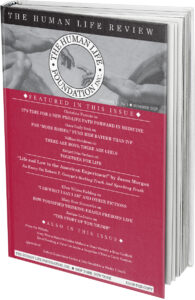The “Right” Way to Have a Baby
The following article was first published by The Dispatch on Sept. 13, 2025. You can read the original here.
Rebecca Smith (a pseudonym) wanted to give a family “the same love I found in becoming a mom,” so she became a surrogate. But when baby Leon died unexpectedly around 29 weeks gestation, his biological mother racked up nearly $1 million in legal fees in her pursuit of “justice”: In other words, making Smith’s life a living hell.
An explosive piece published by Wired last week details how Cindy Bi, the baby’s “intended parent,” became vindictive following her son’s death: hiring a private investigator to look into Smith’s personal life, disparaging her publicly in Facebook posts, and even sending “a photo of Leon’s corpse to Smith’s 7-year-old son’s iPad.” As writer Emi Nietfeld explains, many of the issues in this sordid story “are likely far more common than you’d ever imagine. But you haven’t heard about them. They won’t influence policy or case law, because they tend to unfold in private, shrouded by confidentiality clauses and handled in closed arbitration proceedings.”
Surrogacy, when it does reach the ears of the public, is highly controversial. When actress Lily Collins announced in January that she had a baby via surrogate, onlookers were fiercely divided. “Sorry, Lily Collins, but when people outsource childbirth, their motives really count,” suggested one writer in the Guardian, while Vogue hit back with: “It’s None of Your Business Why Lily Collins Used a Surrogate.” Her husband responded to critics: “It’s ok to not know why someone might need a surrogate to have a child. It’s ok to not know the motivations of a surrogate regardless of what you assume.” And in May, actress Gabrielle Union told off detractors in an interview with Marie Claire, admitting that while surrogacy gave her a child, it wasn’t an easy psychological fix for infertility.
“For me, it felt like failure,” she said. “My body failed. It just felt like such a f—ing public humiliation. Surrogacy felt like a cuckold; watching somebody do something I can’t do. … When it’s never been your reality, I get the urge to judge and cast aspersions because we all want whatever route we took to be the ‘right’ way.”
What is the “right” way to have a baby? Most people will hopefully never have to consider that question. But for those who struggle with infertility and find themselves considering in vitro fertilization, surrogacy, and other interventions made possible only in the past few decades, it can be a nagging question. Is there a “right” way? Do certain interventions violate the rights and dignity of other women? Of newborns?
Jill Rudnitzky Brand, born in 1986, was the world’s first baby born to a surrogate mother with no genetic connection to the embryo. The fledgling technology has since exploded into a $14 billion-plus global industry, and surrogacy is now generally permitted in most states.
According to one 2020 poll, 63 percent of respondents agreed with the idea that “regulated” and “compensated” surrogacy should be legal, while 13 percent of respondents wanted to ban the practice entirely. YouGov data from 2015 reported similar numbers, with 71 percent of Americans approving the practice of surrogacy, and 57 percent saying it was fine to charge money to carry another person’s baby.
The experiences of Collins and Union, however—along with the fact that commercial surrogacy is banned in much of the world—show that the practice is still controversial. But while it’s easy to criticize professionally beautiful women for doing whatever they can to maintain their figures (see the numerous other celebrities who have employed surrogates), it’s harder to criticize mothers who turn to surrogacy after years of struggling with infertility. After all, surrogacy gives them a chance to have their own biological children. What’s so wrong with that?
There is an ickiness to condemning specific instances of surrogacy—one should never look at an infant and say one wishes she weren’t alive—but that doesn’t mean that the practice itself isn’t fraught with ethical quandaries. What if the surrogate bonds with the unborn child and decides to keep him? What if surrogacy is a couple’s last resort after experiencing multiple miscarriages, and the next one to experience the pain of pregnancy loss is the surrogate herself? What if the couple who pays for the surrogate turns out to be unfit or even abusive?
Criticisms of surrogacy typically focus on two of the parties involved: the gestational surrogate (the woman who carries the baby) and the baby herself. Let’s start with the surrogate.
When New York was considering legalizing paid surrogacy (something it ended up doing in 2021), none other than famed feminist Gloria Steinem criticized the move. “Under this bill, women in economic need become commercialized vessels for rent, and the fetuses they carry become the property of others,” she said. New York state Sen. Liz Krueger, a progressive Democrat, similarly opposed the bill. “I do understand the issue of having trouble with fertility. I myself couldn’t have children,” she said. But the legislation would mean “you’re buying and selling eggs, and you’re renting wombs.”
Many feminists argue that paid surrogacy turns a woman into a womb (think dystopian stories like The Handmaid’s Tale or The Giver), and it also entails an uncomfortable power dynamic. Feminist author Andrea Dworkin criticized surrogacy as enabling “women to sell their wombs within the terms of the brothel model,” writing in 1991 that “motherhood is becoming a new branch of female prostitution with the help of scientists who want access to the womb for experiment and power.”
Paid surrogacy almost always involves a wealthy couple—the entire process can cost up to $200,000—and a disadvantaged or low-income woman looking for a financial boost (usually somewhere from $30,000 to $60,000). The surrogate then has to handle various forms of outsourced pain, not just physically, but psychologically. Many clinics will understandably require that both intended parents and surrogates go through counseling. A surrogate may find herself undergoing a miscarriage, having an abortion for reasons of the intended parents’ choosing, or otherwise undergoing circumstances that are physically or contractually out of her control. Indeed, as Nietfeld reported for Wired, “compared to natural conception, carrying a genetically unrelated fetus more than triples the risk of severe, potentially deadly conditions, a statistic surrogates are rarely given.”
A sample surrogacy contract shared by NPR a decade ago goes into explicit detail on compensation (including for maternity clothes), life insurance, and who does or doesn’t have the right to terminate the pregnancy (the “Intended Parents” may require the “Gestational Carrier” to end her pregnancy if the child has medical conditions “incompatible with an acceptable quality of life”). Surrogate mothers are also discouraged from bonding with the newborns who were in their wombs for nine months. “Gestational Carrier and Gestational Carrier’s Husband agree not to form or attempt to form a parent-child relationship with any child born pursuant to this Agreement,” the contract reads.
But part of the bond between mother and baby comes from the physical connection they share. Skin-to-skin contact after birth between the baby and the woman who births her has been shown to have benefits for the woman giving birth (“earlier expulsion of the placenta, reduced bleeding … and lowered maternal stress levels,” according to one study). It also has benefits for the baby: Babies who receive early skin-to-skin contact with their birthing mothers experience less crying; more stable heart rate, breathing, and oxygen levels; and “a beneficial increase in blood sugar,” per Evidence Based Birth. It would be impossible for all but the most hard-hearted of women to carry a baby, even someone else’s, for nine months without feeling at least somewhat attached to her. “Human connection is a basic human need and is the birthright of every new baby,” writes neonatologist Raylene Phillips, arguing that “bonding and attachment can begin before birth” and that health providers “must be aware that prenatal bonding has the potential to improve birth outcomes for both the mother and baby.” Trying to contract your way out of this biology is a fool’s errand.
But even if you tried, surrogacy is still riddled with unknowns. In 2024, Emma Waters, a policy analyst for the Center for Technology and the Human Person at the Heritage Foundation, wrote that the “Families Created Through Surrogacy” study, which New York lawmakers used to argue in favor of commercial surrogacy, “is the only study that specifically examines the surrogate-born child’s psychological adjustment, as well as the only study to do so over an extended period.” Yet, Waters writes, “With such a small sample size, and some families participating inconsistently year-to-year, the study itself runs the risk of selection bias and non-representative outcomes. The study lumps both children born through gestational surrogacy and traditional surrogacy together, too. This means some surrogates are both the genetic mother and the child’s gestational mother.”
There’s a possibility that repeats of the Families Created Through Surrogacy study would find no difference in flourishing between surrogate-borne babies and babies born the usual way. But there’s still a possibility of the opposite.
Despite the scientific and ethical questions it raises, the paid surrogacy industry is booming. Fortune reports that “the number of embryo transfer procedures using a gestational surrogate more than tripled to 9,195 between 2010 and 2019,” and the industry is expected to be valued at $129 billion by 2032.
It can take a while for our ethics to catch up with rapid scientific progress, and the regulation of novel technology becomes all the more important when it concerns the creation of human life itself. Was the story of Smith and Bi, with its tragedy and power imbalance and emotional turmoil, just a fluke? Or is it the story of what happens when an already hopelessly fraught “transaction” goes wrong? When it comes to surrogacy, we need to answer uncomfortable questions about whether the ability to displace a pregnancy is really worth the price—and what that price really is in the first place.











And we have elon musk who is building his Legion.He is paying some women 1-million dollars to be a surrogat for his child.He flies some women to his island resort to copulate and try to concieve a child.I have alway’s been against I.V.F..Multiple human embryo’s are put into a womans womb hoping that one will nidate.All that don’t nidate are “sloughed-off” and perish,die.Some doctors call these “micro-abortions”.